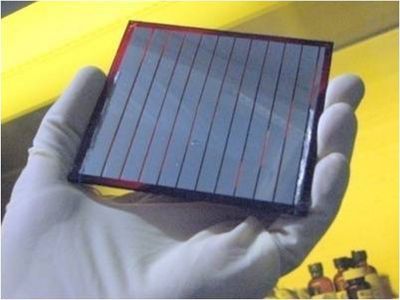New paths to efficient organic solar cells

4inchcell
By Solarmer (talk).Solarmer at en.wikipedia [Public domain], from Wikimedia Commons
EU-funded scientists paved the way to more efficient and cost-effective organic photovoltaics (OPVs) through new material design and novel spectroscopic techniques.
Currently, the performance of OPV blend films — binary mixtures of
electron-donor and electron-acceptor materials — has reached
approximately 10 %. Several loss mechanisms that prevent the extraction
of the photogenerated charges account for their low power conversion
efficiency. These are mainly attributed to the unfavourable
nanomorphology of the OPV blends that instead of promoting free-charge
extraction favour free-charge recombination.
Scientists initiated the EU-funded project 'Delayed luminescence
spectroscopy of organic photovoltaic systems' (DELUMOPV) to provide
further insight into the processes that currently limit the power
conversion efficiency of solution-processed organic OPV devices. To this
end, focus was placed on developing a methodology for tuning the layer
nanomorphology to favour charge extraction and increase photocurrent
generation. Furthermore, DELUMOPV sought to identify alternative
electron acceptors to the presently used expensive fullerene
derivatives.
Scientists confirmed that the delayed luminescence intensity of
delayed excimer (delplex) states in the microsecond timescale is
intertwined with the photocurrent generation efficiency of OPV devices.
In particular, the decay dynamics of the delayed luminescence of the
charge-transfer states provided useful information regarding the charge
transport of the photoactive layers under investigation. Results from
the electric field–induced photoluminescence quenching experiments
showed that free-charge recombination and trapped charges in OPV devices
account for the delayed charge-transfer luminescence.
Scientists designed a state-of-the-art spectroscopic rig to study
delayed luminescence from different material combinations. This involved
using several non-fullerene–based electron-acceptor materials and
polymer electron-donor matrices. Through microscopic techniques,
scientists observed a previously unidentified memory effect in OPV
polymeric composites. The use of a thin interlayer in OPV devices made
of a polymer photoactive layer helped in tuning its morphology to
ultimately optimise charge extraction.
DELUMOPV activities aimed to maintain the EU's competitive advantage
in the organic electronics and OPV fields. Project findings are
expected to serve as a basis for comparisons between fullerene and
non-fullerene–based OPV systems. This should provide valuable feedback
to scientists, enabling the design of next-generation molecular
structures that will combine the advantageous characteristics of both
fullerenes and other polymers.
published: 2015-04-03